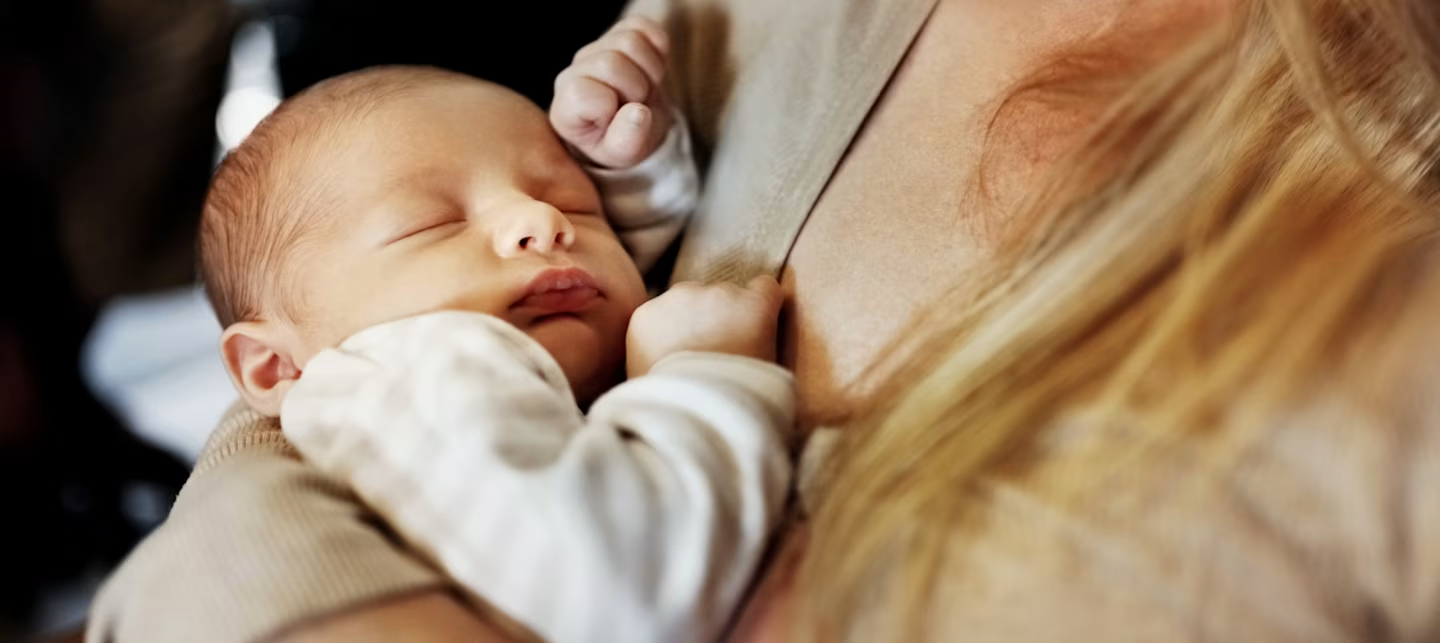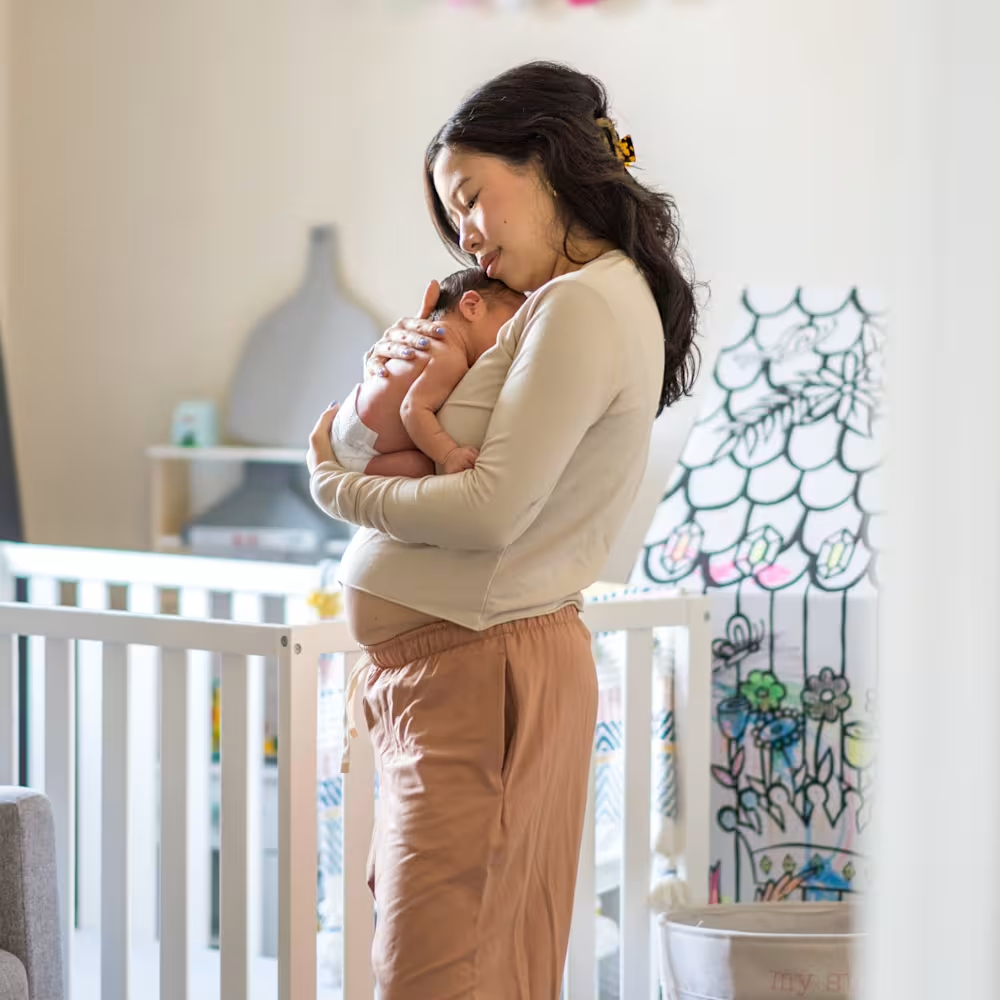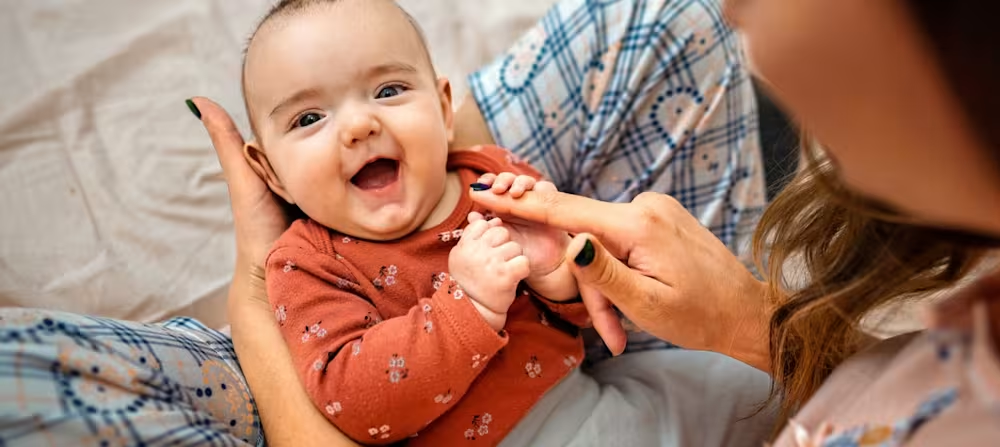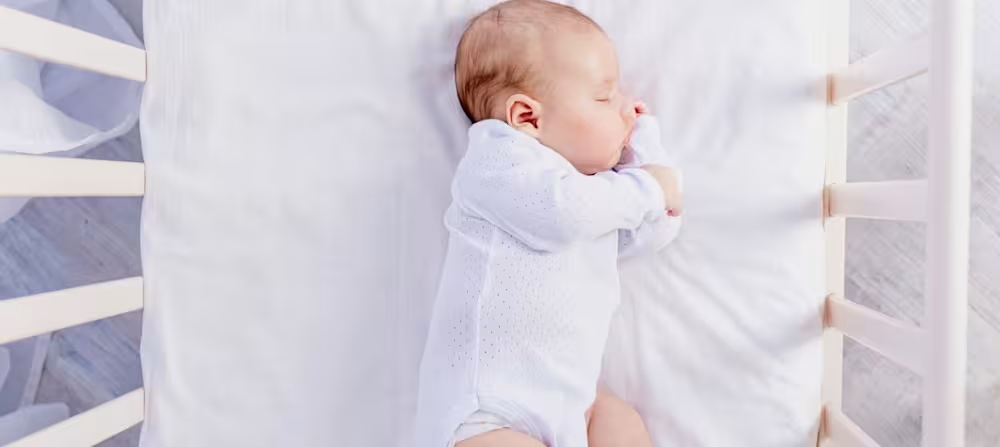Contact napping with a newborn: When it’s okay and how to transition
Updated Oct 22, 2025

Contact napping — those sleepy snuggles on your chest, lap, or shoulder — can feel like magic. It’s the kind of cozy that makes you forget time, or better yet, the kind that turns a gassy newborn into a satisfied little bundle cooing softly into your ear.
In this article, we’ll untangle the hows and whens of contact napping, share tips for if you want to transition away from it, and answer the most asked questions to make sure your little one nods off safely — and you get a moment to breathe, too.
What is contact napping?
Contact napping is exactly what it sounds like: your baby naps while nestled against you. Skin-to-skin or snuggled in a sleep sack, this can happen on your chest, shoulder, or cozied up in your arms.
If your baby is asleep and touching you, it’s a contact nap. So soak it in if you want to! From their small sighs on your rising chest to their tiny hand grabbing your shirt, it’s OK to immerse yourself in the moment. And if you’re ready for your little one to sleep solo? We’ll get to that in a minute too.
Benefits of contact napping for newborns
The hours of cuddly moments do more than help your baby snooze, especially in those early months. Many parents find these cozy naps to be beneficial for their little ones as well as themselves! Here’s why these cozy naps are beneficial for your little one (and you!). Contact napping:
Develops connection
Snuggling while your baby sleeps strengthens attachment, like weaving soft thread to create a blanket. (It’s scientifically-proven!) []. Every gentle stir and soft stretch reinforces a sense of safety and trust that your baby knows they can rely on you. Sometimes these cuddles involve skin-to-skin, which releases oxytocin (a hormone tied to bonding) [].
Betters regulation
Studies demonstrate that contact napping regulates babies’ heart rates and overall cortisol levels (hormones that our bodies release when we’re stressed) []. In fact, their body temperatures often stabilize when they nap in contact with a caregiver []. It’s biology at work — even if it just feels like doomscrolling on your phone for an hour.
Offers comfort
Fussy or overtired newborns may drift off more easily when they’re near you. Your warmth, scent, heartbeat, and steady breathing act like a soft, reassuring current. After all, being close to you feels safe and familiar.
Encourages feeding cues
Close proximity helps you notice hunger cues before crying escalates. That lip smack or restless wiggle becomes an , which can make the difference between calm feeds and full-blown meltdowns.
Is contact napping safe?
Letting your baby sleep on you is generally regarded as safe, as long as you’re awake and alert too. Where things get trickier is when you are exhausted (and let’s be real — most new parents are). If there’s a chance you might fall asleep, moving your baby to a like a crib, bassinet, or bedside sleeper is the safest bet. That way, if you do nod off, your little one is still cozy and safe in their own space.
Tips for safer contact naps []:
Make sure you’re fully awake and alert
Keep your baby resting on your chest or shoulder in an upright position, to ensure their airway is visible and clear
Avoid using loose blankets, pillows, and anything soft near your baby’s face
Never contact nap on a couch, armchair, or other soft or cushioned surfaces, as the risk of sleep-related infant death is much higher
Many parents also find it helpful to “babywear” so that they’re hands-free when running errands or completing household chores, especially in the newborn phase when sleep is so unpredictable. When doing so, ensure the baby's head visible, their airway open, and their chin off their chest. And be careful when doing things like bending over, reaching up, or cooking. Note that the AAP has various recommendations for safe sleep, including if your child falls asleep in a carrier, car seat, stroller, swing, etc., move them to a firm sleep surface as soon as possible [].
The bottom line: contact napping is common and often just happens, especially in the newborn days. Babies will nod off anywhere in those first few months — while being held in the glider, at a grocery store, in the middle of a dinner, or while out walking with friends. With some precautions, contact napping can be a nurturing part of your baby’s early sleep journey and a memory that stays with you forever.
When do babies stop contact napping?
Contact naps can be really helpful between 3 – 5 months, especially after the “.” During this stage, babies are adjusting to lighter, more adult-like sleep cycles and may wake more often between cycles if they don’t havet help. Napping on a parent or caregiver often helps them sleep longer since your warmth, breathing, and movement provide the soothing cues that keep them asleep through transitions. Some families choose to offer 1 or 2 longer contact naps to balance out the shorter crib naps.
However, after about 5 – 6 months, we often recommend gradually moving away from regular contact napping. As babies develop stronger independent sleep skills, they become better able to link sleep cycles on their own — which is the key to longer, more consistent naps in a crib. At that stage, focusing on a calm pre-nap routine and consistently giving your baby a chance to fall asleep in their own space can set the foundation for better daytime sleep overall.
How to transition away from contact napping
Transitioning away from contact napping doesn’t have to be done all at once. Small, repeated opportunities can allow your baby to become accustomed to snoozing in their own space without anyone feeling too overwhelmed by big changes.
How this looks will depend on your baby’s age. Younger babies (newborns to 3 month olds) may still rely heavily on contact to feel secure. As babies approach 3 – 4 months, their sleep cycles mature, and some may call out more for a caregiver between sleep cycles if they depend on movement or holding to fall asleep (what we call external sleep associations). You might also notice that naps become shorter or that it’s harder to transfer them once asleep if this is the case. They often know right away that you are setting them down, and they want more cuddles!
Around this age, you can begin offering more regular opportunities for them to rest in their own sleep space, even if they still want help to fall asleep most of the time. By 5 – 6 months, many babies are developmentally ready to practice longer stretches of crib sleep. Still, changing the way your baby sleeps doesn’t happen overnight. Start slow and build comfort and flexibility — for both of you.
If you’d like more specific sleep help for your little one, Huckleberry can help! With a Premium subscription, you can submit for a Sleep Plan that offers step-by-step guidance that’s tailored to your child’s age and your parenting preferences.
Tips for transitioning away from contact napping
Tip | Explanation |
Follow age-appropriate wake windows | Use wake windows and sleepy cues to time naps and bedtime. As your baby grows (around 6+ months), rely more on wake windows and a consistent routine to avoid overtiredness. |
Give your baby chances to fall asleep independently | Put your baby down when they’re drowsy but awake to help them practice falling asleep on their own. |
Introduce crib naps one at a time | Start with the easiest nap of the day (usually the first nap) in the crib, then add more as your baby adjusts. |
Swaddle newborns safely | Swaddling can help newborns feel secure and sleep longer. Follow “hip-healthy” swaddling practices and stop once your baby shows signs of rolling. |
Make the sleep space familiar | Spend happy, awake moments in the crib — like reading or short play — so your baby associates it with comfort and security. |
Be flexible and kind to yourself | Progress won’t always be steady. Many babies don’t master independent sleep until around 6 months. Celebrate small wins and keep practicing. |
Get expert sleep support | Huckleberry Premium offers personalized Sleep Plans to help your baby (and you) get better sleep. |
Tip #1: Follow age-appropriate wake windows and watch for sleepy cues
For younger babies, using both wake windows and sleepy cues can help you time naps and bedtime to prevent overtiredness. As your little one gets older (i.e. 6 months or older), sleepy cues often become less reliable — so lean more on age-appropriate wake windows and a consistent daily rhythm to guide nap and bedtime timing. When babies are overtired, it can be harder for them to fall and stay asleep, especially as they’re learning to sleep more independently.
Tip #2: Give your baby regular chances to fall asleep on their own
Lay your baby down when they’re sleepy but not completely asleep yet. This gives them the chance to fall asleep independently and nap in their own sleep space instead of being held.
Tip #3: Introduce crib naps one at a time
Pick the easiest nap of the day (usually the first morning nap) and try that in the crib first. Keep that nap predictable; once one crib nap goes well, add another. This is practice and may take some time.
Tip #4: Try swaddling newborns
Newborns like to be cozy! Swaddling can help ease this transition by mimicking the snug, comforting environment they’re used to in your arms — helping them feel secure, sleep longer, and wake less often.
While swaddling can be a helpful tool for encouraging independent sleep, safety is key. Swaddling too tightly can affect hip development, so the AAP promotes “hip-healthy swaddling,” where the baby’s legs have enough room to bend and move freely []. The AAP also advises parents to stop swaddling as soon as their baby shows any signs of rolling.
Tip #5: Make the sleep space familiar during awake times
Spend short, happy, supervised moments in the crib when your baby is wide awake, such as reading or . Helping them get acquainted with their sleep space can help them more willingly go into it for sleep times.
Tip #6: Be flexible and kind to yourself
If you’re looking to transition away from contact napping, it’s expected that progress will be unsteady until closer to 6 months old. Many young babies won’t be able to fully master falling asleep on their own consistently until then. On top of that, regression is normal — sickness, travel, teething, and life happens, even after your baby is accustomed to napping without being held. Celebrate small wins (like a 20-minute crib nap!) and try again tomorrow.
Tip #7: Get a little extra sleep help
With , our sleep experts create a personalized plan to help your baby (and you) get more rest.
When to keep contact napping
Not every nap needs to happen in a crib, and not every parent wants to make that change. Contact naps can be the right choice for many families, whether for comfort, bonding, or simply because it works best right now. Still, it’s important to keep safety in mind: If you think there’s any chance you might fall asleep while holding your baby, move them to a secure crib or bassinet. Falling asleep together on a couch or bed can increase the risk of suffocation.
Here are times when keeping your baby close might be a good option:
If your baby is under 3 months
If your baby is extra fussy or overtired
When you want skin-to-skin bonding
If you're working to improve your breastfeeding goals (skin-to-skin can help!) []
During sick days and
When it’s your preference (that can absolutely be enough of a reason to continue)
Takeaway
Snuggles are powerful: Contact naps strengthen your bond and regulate your baby’s body. Each sigh, stretch, and coo on your chest supports healthy development.
When are contact naps safe: Contact naps are generally safe when you’re alert, upright, and keeping loose blankets or pillows away. If you think you may fall asleep while your baby is sleeping, move your baby to a secure crib or bassinet.
You can take transitions at your own pace: If contact napping isn’t working for your family anymore, make changes at your own pace. Independent sleep skills come with age and practice. Start small by giving your baby opportunities to fall asleep on their own, get used to their sleep space while awake, and use a mix of sleepy cues and age-appropriate wake windows to guide timing. As babies grow, cues can become less obvious, so lean more on wake windows and a consistent routine to help with nap and bedtime timing.
Find what works for your family: If you want to continue contact napping, that works too! Find the balance that works for you and your little one.
Contact napping FAQ
Share article:
Note: The content on this site is for informational purposes only and should not replace medical advice from your doctor, pediatrician, or medical professional. If you have questions or concerns, you should contact a medical professional.
7 Sources
Share article:







